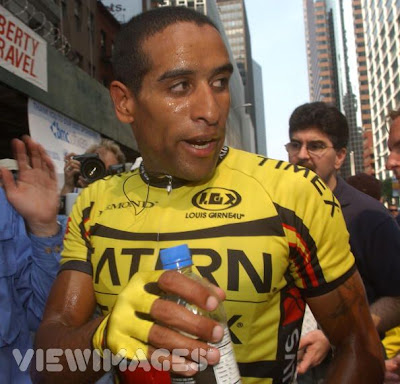Fresh from CNN this morning. We all know this, but here's the research proving itself true time and time again. Pay attention to the statements about heart shrinking in size after a professional career, yet being in phenomenal shape. Also note the bigger danger doping can cause to the athlete with a bigger heart. I wish some pro cyclists would realize this aspect. (I'm going to try and get that bigger heart by cycling more ! Yeehaww...)
Tour de France cyclists' hearts bigger than normal
VIENNA, Austria (AP) -- Riding the grueling Tour de France bike race takes strength, stamina -- and perhaps a heart nearly 40 percent bigger than normal.
Researchers who examined the hearts of former Tour bikers found that the athletes' hearts were from 20 to 40 percent larger than average, said Dr. Francois Carre of the Centre Hospitalier Universitaire de Rennes, France, speaking at a meeting of the European Society of Cardiology.
The difference is attributable largely to rigorous training that expands the cyclists' hearts. But researchers have not yet determined whether the athletes' hearts were larger to begin with.
"They are a special breed," said Dr. Richard Becker, a professor of medicine at Duke University and spokesman for the American Heart Association. Becker was not connected to Carre's study.
Scientists have long noticed the phenomenon of the "athlete's heart." Athletes who train hard in aerobic sports, such as cycling, running or swimming, tend to have a bigger heart that pumps more blood throughout the body.
The heart's walls become thicker to be able to handle the increased blood volume. That gives the athletes an edge by increasing their oxygen levels and improving their endurance.
Carre's study, funded by the Brittany provincial government in France, is perhaps the first to track what happens to athletes' hearts when they stop training.
Medical tests done on all Tour de France cyclists before the race begins showed virtually all have enlarged hearts, Carre said.
"When you see an athlete's heart test, you know right away that it's not a normal person," he said.
In his study, Carre tracked seven former professional cyclists through their final year of competition and three years of retirement.
Once a year, the cyclists took tests to check the size and function of the heart. They were also tested on their fitness levels.
Carre found that the athletes' hearts shrank nearly a quarter in size after they finished riding professionally. Still, the cyclists remained in excellent physical condition.
"Some athletes have a genetic predisposition to perform better," Carre said. "But we found that in these cyclists, their hearts adapted to the hard training conditions by just getting bigger."
The intense training that Tour de France athletes undergo to race in a three-week-long competition cycling up and down mountains is arguably among the toughest in professional sports.
"When you examine Tour de France athletes, they are probably among the best-trained athletes in the world," said Dr. Alfred Bove, a physician for the Philadelphia 76ers basketball team and vice president of the American College of Cardiology. "This study shows us that even in extreme conditions, the body finds a way to adapt."
Bove said that in athletes with bigger hearts, doping could prove potentially more dangerous than for normal people.
Athletes with bigger hearts have more red blood cells, which deliver oxygen around the body. These cells are thicker than normal cells. So if athletes decide to use an illegal agent like the blood-booster EPO, they run the risk of making their blood too thick. That puts them in danger of a clot, stroke, or heart attack.
"These athletes already have hearts that have increased in volume to adapt to their training workload," Bove said. "If they then go and use drugs, that could potentially erase the natural advantage they already have."
















































